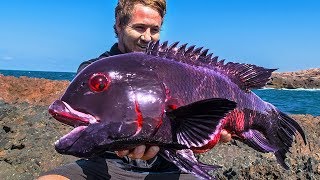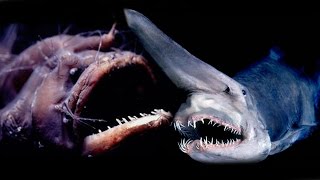Friday, 02 January, 2026г.
















Где искать: по сайтам Запорожской области, статьи, видео ролики
пример: покупка автомобиля в Запорожье
World's DEADLIEST Deep Ocean Animals
From massive marine mammals … to ferocious fish and scary sharks ... here are 18 of the world’s deadliest animals in the deep ocean
Subscribe to Epic Wildlife http://goo.gl/6rzs5u
Let's Connect
-- http://www.epicadamwildlife.com/
-- http://www.facebook.com/epicadamwildlife
-- http://www.twitter.com/epicwildlife
-- http://gplus.to/epicwildlife
#9 Deep Sea Dragonfish
This is definitely an odd fish since it looks more like an eel. The creature has no scales, and its skin is slimy and slippery. And living up to its name, this animal has a terrifying face and a mouth filled with enormous teeth. Experts say the creature uses bioluminescence as a means of communication or to camouflage itself. It can attract prey with a glowing barbel (or whisker) that is used as a lure. And it provides some light in the dark, cold waters 6,000 feet below the surface (1,828m).
#8 Goblin Shark
Just the appearance of this beast might be deadly enough to kill an aggressor. This creature’s best known physical trait is its scary mouth. It has jaws that pop out of its mouth to snare prey with sharp, nail-like teeth. It’s been noted before how the effect is reminiscent of the Xenomorph in the Alien movies. Since they dwell in cold waters that are nearly 5,000 feet deep (1,370 meters), they’re not seen so often. Maybe that’s a good thing.
#7 Black Scabbardfish
They have a scary look to go along with that intimidating name. The eel-like creatures can weigh up to 15 pounds (7 kg) and measure close to 4 feet (1.2 m). Their large snouts contain fanglike choppers used for preying on cephalopods, crustaceans and other fish. They can typically live at depths from 600 feet (122 m) to more than 5,000 feet deep (1524 m). Because of that extreme depth, fishermen have to use specialized deepwater lines to catch the fish.
#6 Lizardfish
They’re usually small, but certain species can reach almost 2 feet (61 cm) in length. They’re called lizardfish due to their body shape which is cylindrical and slender, not unlike a lizard’s. This creature has dark, scaly skin and a mouthful of needle-like teeth, which includes the sharp teeth on its tongue. They’re often found in shallow coastal waters, although some species live at depths of 1300 feet (396 m). When living in sandy environments, lizardfish can camouflage themselves by changing their body colors.
#5 Deepwater Stingray
The very name of this critter lets you know that it’s found in deep waters, typically more than 2,200 feet (680 m) below the surface. But they can hunt prey from the seafloor to the open water as they search for bony fishes and crustaceans. This species can reach nearly 9 feet long (2.7 m) and 5 feet wide (1.5 m), and is found throughout the Indo-Pacific. They’re known to have powerful tails, which can pose a danger to humans. If these rays are caught by fisheries, they can start flailing their long, venomous stingers which could inflict some considerable damage.
#4 Northern Stargazer
Not only do these critters have some scary features, but they also have some scary abilities. They are venomous, and certain species can generate electric shocks to discourage predators. You might think that their frightening appearance would help to scare off aggressors as well, but it doesn’t serve that function. The animals have top mounted eyes which allow them to watch overhead for prey while they stay buried in the seafloor sand.
#3 Tiger Shark
The dark striping of these apex predators inspires the comparison to the big cats. While they’ll typically swim at depths of 1,148 feet (350 meters) below the surface, they’ll also appear near the coastline. These animals are infamous for their voracious appetite and will consume anything from crustaceans and dolphins to sea snakes and man-made objects that are inedible. They can pose a danger to humans due to their habit of entering shallow waters. Did you know that tiger sharks were said to be responsible for ten deaths along the coast of Hong Kong during four years in the 1990s?
#2 Colossal Squids
These cephalopods are regarded as the world’s largest known invertebrates, as measured by mass. And they possess the largest eyes known within the animal kingdom, measuring up to 16 inches in diameter (41 cm), or about the size of a dinner plate. The largest specimen caught to date weighed nearly 1,100 pounds (499 kg) while measuring around 15 feet (4.6 m) long, But experts think the creatures could potentially attain dimensions that are much greater than that. They inhabit cold water environments exceeding 7,000 feet (2.2 km) which explains their deep sea gigantism (jie-GAN-tiz-um). The squid's arms and tentacles have sharp, deadly hooks used to capture prey. But they often serve as prey for larger animals like beaked whales.
1...
Теги:
sea creatures creatures ocean sea deep sea deep sea creatures sea monsters facts deep sea creature shark list animals monsters sea animals top ten giant squid wildlife interesting biggest bizarre most mysterious ocean creatures deep sea monsters deep sea animals creepy sea creatures underwater giant scariest sea creature mysterious creatures ocean animals goblin shark dangerous animals scary in the world great white shark deepest mariana trench
Похожие видео
Мой аккаунт


 У вашего броузера проблема в совместимости с HTML5
У вашего броузера проблема в совместимости с HTML5


